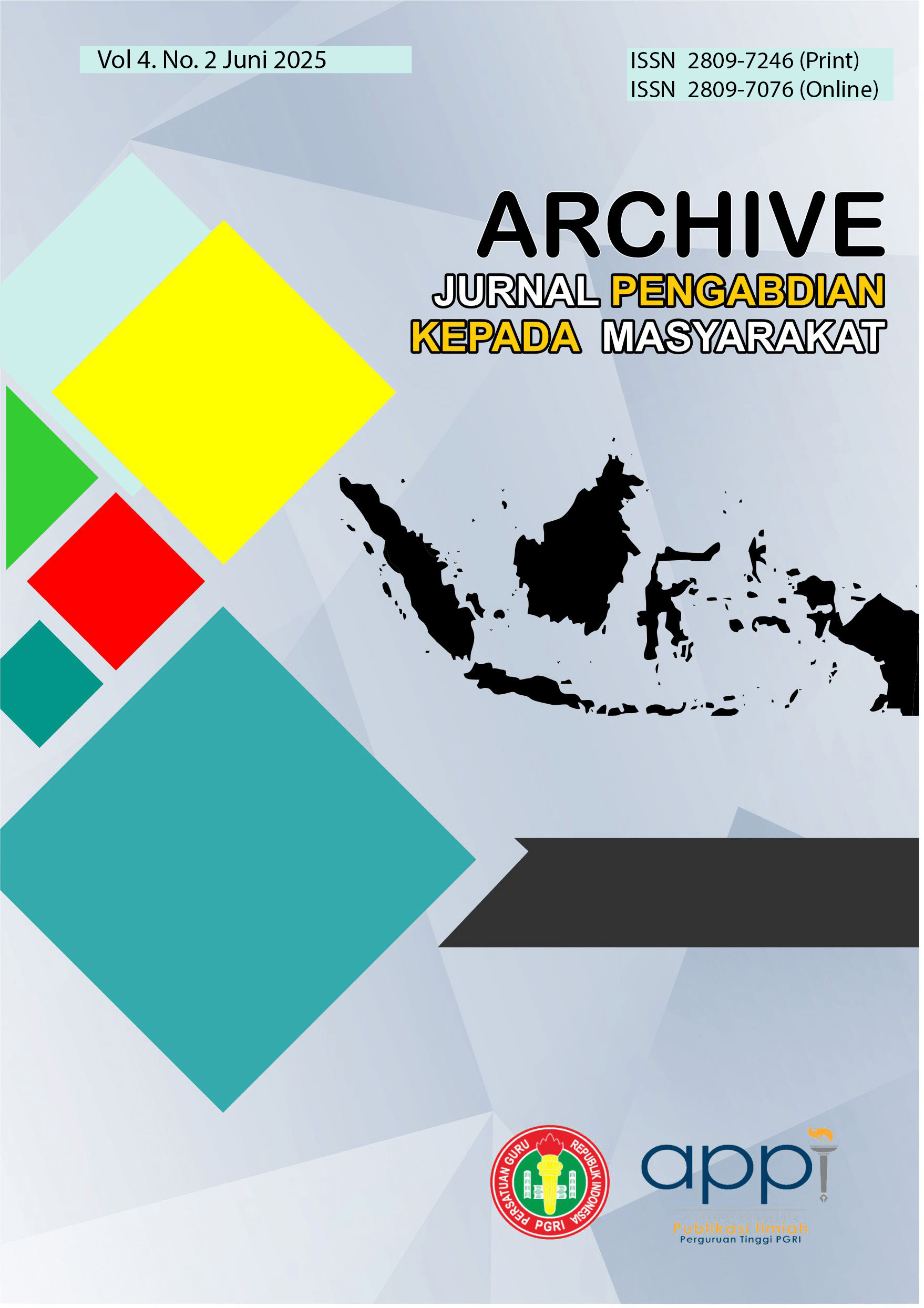Edukasi Interaktif Latih Anak Hidup Damai dan Bebas dari Narkoba Melalui Pendekatan Keluarga
DOI:
https://doi.org/10.55506/arch.v4i2.166Keywords:
Edukasi Interaktif, Hidup Damai, Bebas Narkoba, Pendekatan KeluargaAbstract
Latar Belakang: Perkembangan teknologi memberikan dampak positif dan negatif bagi anak dan remaja. Namun, terdapat risiko peredaran narkoba akibat kurangnya dukungan keluarga. Urgensinya, keluarga memegang peranan penting dalam membentuk karakter dan ketahanan anak. Tujuan: Program ini bertujuan untuk mengembangkan pendidikan interaktif berbasis keluarga guna menanamkan nilai-nilai hidup damai, keterampilan sosial, dan kesadaran anak sejak dini dalam menolak narkoba melalui pendekatan dialogis, bermain, dan simulasi, dengan melibatkan peran aktif orang tua. Metode: Metode ini memiliki tahapan observasi, perencanaan, pelaksanaan, dan evaluasi dengan pendekatan bercerita berbasis keluarga. Hasil: Hasil pendidikan interaktif dengan metode bercerita menanamkan nilai-nilai damai dan menolak narkoba pada anak. Anak menjadi lebih tanggap, dan orang tua merasa bahwa komunikasi positif bersifat konstruktif. Kesimpulan: Layanan ini membuktikan bahwa mendongeng berbasis keluarga secara efektif menanamkan nilai-nilai perdamaian, meningkatkan kewaspadaan anak terhadap bahaya narkoba, dan memperkuat komunikasi serta ketahanan emosional anak sejak usia dini.
Downloads
References
Bottaro, R., & Faraci, P. (2022). The Use of Social Networking Sites and Its Impact on Adolescents’ Emotional Well-Being: A Scoping Review. Current Addiction Reports, 9(4), 518–539. https://doi.org/10.1007/s40429-022-00445-4 DOI: https://doi.org/10.1007/s40429-022-00445-4
Cagiltay, B., Ho, H.-R., Sun, K., Su, Z., Wu, Y., Richards, O. K., Jin, Q., Yu, J., Fails, J. A., Yip, J., & Forlizzi, J. (2024). Methods for Family-Centered Design: Bridging the Gap Between Research and Practice. Extended Abstracts of the CHI Conference on Human Factors in Computing Systems, 1–6. https://doi.org/10.1145/3613905.3636290 DOI: https://doi.org/10.1145/3613905.3636290
Cagiltay, B., Ibtasar, R., Michaelis, J. E., Sebo, S., & Mutlu, B. (2023). From Child-Centered to Family-Centered Interaction Design. Proceedings of the 22nd Annual ACM Interaction Design and Children Conference, 789–791. https://doi.org/10.1145/3585088.3589930 DOI: https://doi.org/10.1145/3585088.3589930
Daeng, M. Y., & Yusuf, M. F. D. (2021). Legal Protection for Children Victims of Narcotics Abuse in Riau Province. International Journal of Law and Public Policy (IJLAPP), 3(2), 100–106. https://doi.org/10.36079/lamintang.ijlapp-0302.265 DOI: https://doi.org/10.36079/lamintang.ijlapp-0302.265
Habib, M., & Nadira, D. (2024). The role of the family in character education for children. ONTOLOGI: Jurnal Pembelajaran Dan Ilmiah Pendidikan, 2(1), 27–36.
Hanson, G. R., Venturelli, P. J., & Platteborze, P. (2024). Drugs and society. Jones & Bartlett Learning.
Kumpfer, K. L. (2000). Family skills training for parents and children. US Department of Justice, Office of Justice Programs, Office of Juvenile ….
LaForett, D. R., & Mendez, J. L. (2020). Children’s engagement in play at home: A parent’s role in supporting play opportunities during early childhood. In Reconsidering The Role of Play in Early Childhood (pp. 228–241). Routledge. https://doi.org/10.4324/9780429429453-17 DOI: https://doi.org/10.4324/9780429429453-17
Limone, P., & Toto, G. A. (2021). Psychological and emotional effects of digital technology on children in COVID-19 pandemic. Brain Sciences, 11(9), 1126. https://doi.org/10.3390/brainsci11091126 DOI: https://doi.org/10.3390/brainsci11091126
Luna, E. (2016). Drug War and Peace. U.C. Davis Law Review, 50, 813.
Marino, C., Gini, G., Angelini, F., Vieno, A., & Spada, M. M. (2020). Social norms and e-motions in problematic social media use among adolescents. Addictive Behaviors Reports, 11, 100250. https://doi.org/10.1016/j.abrep.2020.100250 DOI: https://doi.org/10.1016/j.abrep.2020.100250
Mehri, S. M., Hashemian, M., Joveini, H., Sharifi, N., Rakhshani, M. H., & Assarroudi, A. (2023). The effect of web-based family-centered empowerment program in preventing the risk factors of substance abuse in students’ parents; application of the health promotion model. Journal of Education and Health Promotion, 12(1), 175. https://doi.org/10.4103/jehp.jehp_831_22 DOI: https://doi.org/10.4103/jehp.jehp_831_22
Mırazanashvılı, N., & Qurdadze, P. (2020). The impact of the folk fairy tales on the early stage of a child development. Karadeniz Uluslararası Bilimsel Dergi, 46, 27–35. https://doi.org/10.17498/kdeniz.703614 DOI: https://doi.org/10.17498/kdeniz.703614
Nawi, A. M., Ismail, R., Ibrahim, F., Hassan, M. R., Manaf, M. R. A., Amit, N., Ibrahim, N., & Shafurdin, N. S. (2021). Risk and protective factors of drug abuse among adolescents: A systematic review. BMC Public Health, 21(1), 2088. https://doi.org/10.1186/s12889-021-11906-2 DOI: https://doi.org/10.1186/s12889-021-11906-2
O’Reilly, M. (2020). Social media and adolescent mental health: The good, the bad and the ugly. Journal of Mental Health, 29(2), 200–206. https://doi.org/10.1080/09638237.2020.1714007 DOI: https://doi.org/10.1080/09638237.2020.1714007
Pakpahan, E., Sahari, A., & Fauzi, A. (2022). Legal Protection for Children as Victims of Narcotics Abuse (Research Study at the Belawan District Attorney’s Office). International Journal Reglement & Society (IJRS), 3(3), 248–256.
Saputra, W. N. E., Supriyanto, A., Astuti, B., & Ayriza, Y. (2020). Konseling Kedamaian Berbasis Kearifan Lokal Strategi Konselor Mereduksi Perilaku Agresi. Universal Journal of Educational Research, 8(2), 631–637. https://doi.org/10.13189/ujer.2020.080236 DOI: https://doi.org/10.13189/ujer.2020.080236
Saputra, W. N. E., Supriyanto, A., Rohmadheny, P. S., Astuti, B., Ayriza, Y., & Adiputra, S. (2021). The Effect of Negative Peace in Mind to Aggressive Behavior of Students in Indonesia. European Journal of Educational Research, 10(1), 485–496. https://doi.org/10.12973/eu-jer.10.1.485 DOI: https://doi.org/10.12973/eu-jer.10.1.485
Sri, H., Agus, S., Amien, W., Anwar, S., & Rezki, P. S. (2020). Group guidance with folklore method as alternative to develop tolerance character. https://philpapers.org/rec/SRIGGW
Stormshak, E., Caruthers, A., Chronister, K., DeGarmo, D., Stapleton, J., Falkenstein, C., DeVargas, E., & Nash, W. (2019). Reducing risk behavior with family-centered prevention during the young adult years. Prevention Science, 20, 321–330. https://doi.org/10.1007/s11121-018-0917-2 DOI: https://doi.org/10.1007/s11121-018-0917-2
Supriyanto, A. (2016). Collaboration Counselor and Parent for Developing Student Spiritual Competency trough Comprehensive Guidance and Counseling Service. Jurnal Fokus Konseling, 2(1). https://ejournal.umpri.ac.id/index.php/fokus/article/view/131/0
Supriyanto, A. (2021). Bimbingan Dan Konseling Narkoba. Yogyakarta: K-Media
Supriyanto, A., Hendiani, N., Hartini, S., & Sabri, F. (2021). Addiction counselor profession: Perception of family support for recovering from drug abuse addiction. Counsellia: Jurnal Bimbingan Dan Konseling, 11(1), 17–30. https://doi.org/10.25273/counsellia.v11i1.8585 DOI: https://doi.org/10.25273/counsellia.v11i1.8585
Supriyanto, A., Hendiani, N., Wahyudi, A., Purwadi, P., & Fauziah, M. (2020). Peer Guidance: Development of Children’s Wellbeing on Addicted Parents. Counsellia: Jurnal Bimbingan Dan Konseling, 10(1), 69–82. https://doi.org/10.25273/counsellia.v10i1.6214 DOI: https://doi.org/10.25273/counsellia.v10i1.6214
Supriyanto, A., Wibowo, M. E., Mulawarman, M., & Japar, M. (2024). A valid and reliable self-peace scale with indicators of love, care and fearlessness for adolescent drug users. Retos: Nuevas Tendencias En Educación Física, Deporte y Recreación, 58, 247–255. https://doi.org/10.47197/retos.v58.102567 DOI: https://doi.org/10.47197/retos.v58.102567
Treewong, P. (2023). Fairy Tales and Promotion of Early Childhood Development. Community and Social Development Journal, 24(3), 105–113. https://doi.org/10.57260/rcmrj.2023.264131 DOI: https://doi.org/10.57260/rcmrj.2023.264131
Walid, D. A., Jusoh, A. J., & Omar, S. Z. (2021). A review of drug prevention program: Implementation in several countries. International Journal of Education, Information Technology, and Others, 4(3), 500–511.
Warsongko, D. S., Miranda, S. K., & Ghozali, M. A. (2024). Group guidance with photovoice technique to increase empathy of student. Journal of Professional Teacher Education, 2(1), 9–16. https://doi.org/10.12928/jprotect.v2i1.646 DOI: https://doi.org/10.12928/jprotect.v2i1.646
Downloads
Published
How to Cite
Issue
Section
License
Copyright (c) 2025 Agus Supriyanto, Nurlita Hendiani, Amien Wahyudi, Febritesna Nuraini, Arif Budi Prasetya

This work is licensed under a Creative Commons Attribution-ShareAlike 4.0 International License.
1. Hak cipta atas artikel apa pun dipegang oleh penulisnya.
2. Penulis memberikan jurnal, hak publikasi pertama dengan karya yang dilisensikan secara bersamaan di bawah Lisensi Atribusi Creative Commons yang memungkinkan orang lain untuk membagikan karya dengan pengakuan atas kepenulisan dan publikasi awal karya tersebut dalam jurnal ini.
3. Penulis dapat membuat pengaturan kontrak tambahan yang terpisah untuk distribusi non-eksklusif dari versi jurnal yang diterbitkan dari karya tersebut (misalnya, mempostingnya ke repositori institusional atau menerbitkannya dalam sebuah buku), dengan pengakuan dari publikasi awalnya di jurnal ini.
4. Penulis diizinkan dan didorong untuk memposting karya mereka secara online (misalnya, di repositori institusional atau di situs web mereka) sebelum dan selama proses pengiriman, karena hal itu dapat mengarah pada pertukaran yang produktif, serta kutipan yang lebih awal dan lebih besar dari karya yang diterbitkan.
5. Artikel dan materi terkait yang diterbitkan didistribusikan di bawah Lisensi Internasional Creative Commons Attribution-ShareAlike 4.0














